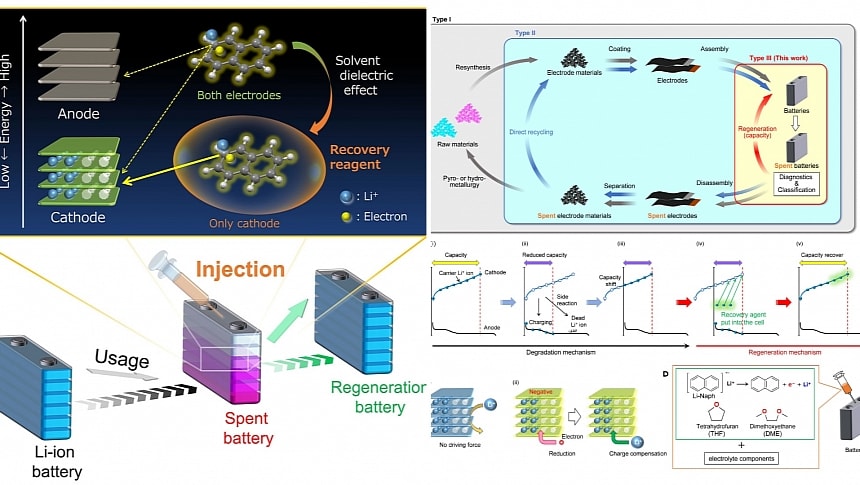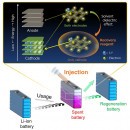Li-ion batteries used in electric vehicles are designed for long service life but will eventually lose capacity and need replacement. A group of researchers at Toyota Central R&D Labs in Japan found a simple way to reverse the aging process and extend their life cycle.
Studies have shown that lithium-ion batteries in electric vehicles are quite reliable, thanks to efficient management systems that regulate temperature and charge/discharge performance. Replacing an EV battery is a very rare occurrence, with most electric vehicles still on their original battery after hundreds of thousands of miles and years of service.
No matter how good Li-ion batteries have gotten, they will gradually lose capacity over time as the number of lithium ions decreases. When this happens, they need to be charged more often and are less reliable. For instance, in cold weather, they might not be able to provide the full power necessary during normal operation, causing them to deplete unexpectedly. Being unable to rely on the range calculated by the car's computer is a big issue with electric vehicles.
When this happens, a used battery will need to be replaced with a new one, which is usually expensive. The spent battery can be used in other applications with lower requirements or recycled. However, a group of researchers from Toyota Central R&D Labs in Japan found a better way. They discovered that injecting specific chemicals into the cell can restore them to almost full capacity. The injection triggers a reaction that creates more charged particles (lithium ions and electrons).
The substance used in this single-step process is called a recovery reagent and is able to reverse the degradation of the battery and restore up to 80 percent of its original capacity. During their experiments, the scientists found out that the restored battery maintained its performance for 100 charge/discharge cycles. The method was tested on small and large batteries, including those used in electric vehicles, and proved its efficiency.
However, the technique does not cure any type of battery degradation. The chemical injection method works for batteries that have lost their ions due to repeated charging and discharging. Cells that suffered structural damage or another form of deterioration are out of luck. This is why the cells must be diagnosed to determine whether they can be rejuvenated with the chemical injection. This poses a challenge, as finding a simple, non-destructive method to assess the battery state is not trivial.
It's still premature to understand the potential side effects of the chemical injection on the battery and its safety. There's no point in attempting this rejuvenation method only to have the battery burst into flames later. Although rare, battery fires do happen and are notoriously difficult to extinguish. However, if this method works, it can reduce waste and save money.
No matter how good Li-ion batteries have gotten, they will gradually lose capacity over time as the number of lithium ions decreases. When this happens, they need to be charged more often and are less reliable. For instance, in cold weather, they might not be able to provide the full power necessary during normal operation, causing them to deplete unexpectedly. Being unable to rely on the range calculated by the car's computer is a big issue with electric vehicles.
When this happens, a used battery will need to be replaced with a new one, which is usually expensive. The spent battery can be used in other applications with lower requirements or recycled. However, a group of researchers from Toyota Central R&D Labs in Japan found a better way. They discovered that injecting specific chemicals into the cell can restore them to almost full capacity. The injection triggers a reaction that creates more charged particles (lithium ions and electrons).
The substance used in this single-step process is called a recovery reagent and is able to reverse the degradation of the battery and restore up to 80 percent of its original capacity. During their experiments, the scientists found out that the restored battery maintained its performance for 100 charge/discharge cycles. The method was tested on small and large batteries, including those used in electric vehicles, and proved its efficiency.
However, the technique does not cure any type of battery degradation. The chemical injection method works for batteries that have lost their ions due to repeated charging and discharging. Cells that suffered structural damage or another form of deterioration are out of luck. This is why the cells must be diagnosed to determine whether they can be rejuvenated with the chemical injection. This poses a challenge, as finding a simple, non-destructive method to assess the battery state is not trivial.
It's still premature to understand the potential side effects of the chemical injection on the battery and its safety. There's no point in attempting this rejuvenation method only to have the battery burst into flames later. Although rare, battery fires do happen and are notoriously difficult to extinguish. However, if this method works, it can reduce waste and save money.






